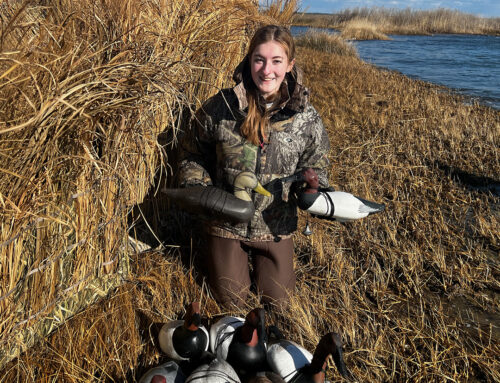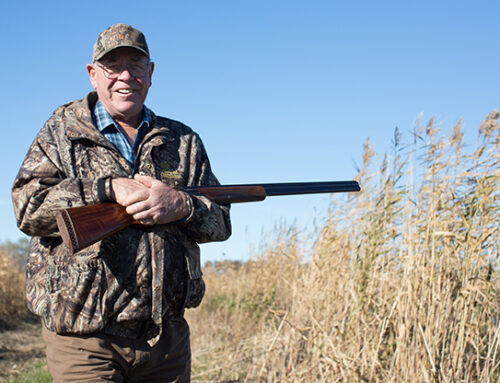A Goose Against All Odds

A late April snow-goose hunt in central South Dakota generally offers up lower than usual odds of success. Delta Waterfowl digital media creator Ben Peterson and his buddy Lucus Bergquist of Bismarck, North Dakota, knew that. But they’d also heard talk of some birds that had been pushed back into the area a couple weeks earlier by late storms on the Canadian border. They decided to give them a try.
Upon arriving, they found some geese. Their recon told them afternoon would be the best time to hunt, so Peterson and Bergquist located a field to put out their rig. Action was fairly steady, but seeing 20-25 snows and Ross’s geese wasn’t many for the miles they’d logged.
Then a lone bird came in on the left edge of the spread — Bergquist’s side. The goose didn’t hesitate. It just came in and set its wings. At the last second, the hunters realized something was funky — out of place — with this goose. That threw Bergquist’s concentration and he missed the first shot, but recovered and dumped it with his second.

It wasn’t until the dog delivered the Ross’s goose to Peterson’s hand they realized what they’d taken. While Peterson has taken collared geese before, this one was different. From pictures he had once been shown by Delta’s waterfowl scientist, Chris Nicolai, Peterson recognized the white collar covered in solar panels as a GSM tracking collar. This particular type of collar gives off a “ping” of the bird’s location every 15 minutes. It is an elite device.

He knew that Nicolai had been deeply involved in these light goose GPS collaring programs, so he took a photo and texted it to him with a one-word message: “Sorry!”
Before we dig into the goose’s history, let’s start adding up the long-shot chances of this event: Hunting late in the season + few birds in the area + a slow-ish day + two out-of-state hunters + an afternoon hunt + a collar-tagged Ross’s goose + a GPS unit + a goose linking two colleagues at Delta Waterfowl! But that’s only the beginning of the long odds.
Nicolai knew just where to go to learn the history of the goose. It was an adult male collared at the Colusa National Wildlife Refuge in California’s Central Valley in March of 2019 by California Waterfowl Association biologists Caroline Brady and Brian Huber. The capture and release was part of a cooperative research project directed by the USGS-Dixon Field Station and California Department of Water Resources. This ongoing study is to determine how the growing goose populations in the Central Valley affect ducks and other waterfowl. (Visit the USGS.gov website for full details of the research.)
Little did the hunters know this goose held a world record, to boot. According to Nicolai, this bird was known to provide GPS tracking data for a longer time than any other individual Ross’s goose.
“I’ll bet you this is the longest any Ross’s goose has ever carried any kind of telemetry, let alone GPS,” Nicolai said. “Ross’s and brant are sensitive about getting anything stuck on them. They find a way to get it off or occasionally it kills them. It’s also a unique bird because it jumped from the Pacific Flyway to the Central Flyway across two winters.”
From its tagging in 2019 to its fateful encounter with Bergquist and Peterson in central South Dakota in spring 2020, the goose was tracked for more than 400 days.

Looking at the satellite tracking map of the goose’s travels, in spring of 2019 it left central California and migrated to breeding grounds at the long-famous Queen Maud Migratory Bird Sanctuary. Nicolai says that it appears to have failed at nesting and then moved on to King William Island on the shores of the Beaufort Sea in the Canadian high arctic to molt. In early fall, it began its southern migration and looked as though it was on course to return to California, but abruptly at the Alberta/Saskatchewan border, it veered sharply southeast and took a course across the Dakotas on its way to winter in the Texas panhandle.
With spring coming on, the goose was northbound again, but took a circuitous route up the eastern Central Flyway, likely influenced by weather patterns. The tracking shows it nearly crossed into Manitoba, but turned around and headed south several hundred miles again nearly to northern Nebraska before meeting up with Bergquist and Peterson in that South Dakota cornfield.

“We should have gone straight from the field to buy lottery tickets,” Peterson said. “The odds of us meeting up with that goose make winning the lottery look really, really easy.”
The lucky duo is sending the working radio back to master’s degree student Andrea Mott. She will send them a souvenir replacement collar and a very descriptive map, and will redeploy the still-working collar on another goose to continue the study. —Bill Miller






December 24 I shot a Mallard Drake with a solar gps tracker. Dr Nicolai returned my call Christmas Eve night and sent me maps and
all the info on the tracking of the Mallard I shot. We talked on the phone the next week and he sent me more info and I mailed the tracker back. What a great guy to talk ducks with and very giving of his time to send all info and answer questions.
Thanks Dr. Nicolai and Delta Waterfowl for all you hard work and working for the Duck Hunter.